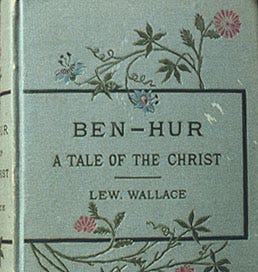Ben-Hur (book) > Ben-Hur (movie)
"Out of that vast tomb Christianity issued to supersede the Caesars.”
I finally watched the 1959 Ben-Hur film with Charlton Heston and it lived up to the hype. It’s a fantastic movie that can still hold its own more than six decades later.
The depiction of hostilities between Rome and Judaea (embodied so perfectly in the turbulent relations of Mesalla and Ben-Hur), the galley scenes and naval warfare, the chariot racing, interposed between vignettes of Christ—it’s all excellent and well deserving of its place in cinema fame.1
Nevertheless, the book (published in 1880 by General Lew Wallace) is better and you should put it at the top of your list if you’re looking for some good fiction.2
SPOILER ALERT
(Don’t read beyond if you are worried about spoilers for either the book or the movie, though both are still incredible even if you know the plot in advance…)
Here’s what the book has that the movie lacks:
More wise men.
While the film briefly depicts all three wise men (Balthasar, Gaspar, and Melchior) and has a few decent scenes with Balthasar thereafter, the entire first third of the book (eight chapters!) details the meeting of the Magi and then their visitation of baby Jesus. The film cut is understandable but tragic, as each Magi speaks of his civilization’s particular greatness, making the Nativity all the more incredible as the great civilizations of the Earth come to pay homage to the newborn king.
Simonides’ long-faithfulness with his master’s fortune.
In the book and movie, the family’s servant, Simonides, endures torture as the Romans seize as much of the wealth of Hur as they are able once he is enslaved in the galleys. However, in the book, Simonides has far more success managing his master’s finances. He faithfully invests his master’s money in his absence, and when Ben-Hur returns from the slave galley, he learns that he has a small fortune thanks to Simonides.
The various factions in Judaea. Ben-Hur alludes to two of these in the film (those who support violent revolution vs. those who do not) but the granularities of difference are on display in the book as you encounter Sadducees, Pharisees, Zealots, tax collectors.
The ending is longer and substantially different.
In the book, Ben-Hur becomes a Zealot of sorts, organizing three legions of fighters to counter Rome after learning (falsely) of the death of his family at Roman hands. When he later learns that they are alive, but lepers, he brings his mother and sister to Jesus to be healed.
When Jesus is taken into custody, he discourages any sort of rescue effort by Ben-Hur. As his legions turn against the “failed” messiah, Ben-Hur realizes that Christ’s kingdom is to be a spiritual one.
As Christ dies from crucifixion, Ben-Hur realizes that Balthasar, who had long sought and followed Christ, is also dead. “Ben-Hur remembered to have heard a cry in answer, as it were, to the scream of the Nazarene in his last moment… and ever after he believed the spirit of the Egyptian accompanied that of his Master over the boundary into the kingdom of Paradise.”
The book goes on where the movie ends,3 flashing forward five years as Ben-Hur takes the vast sums he has received from Simonides’ faithfulness, his adoptive Roman father Arrius, and (at the very end) Sheik Ilderim and asks Simonides what he ought to spend it on. The conversation goes as follows:
S: “The great sums you have given to the Church here in Antioch, I am witness to. Now, instantly almost with this gift of the generous sheik’s, comes the news of the persecution of the brethren in Rome. It is the opening of a new field. The light must not go out in the capital.”
B: “Tell me how I can keep it alive.”
S: “I will tell you. The Romans, even this Nero, hold two things sacred—I know of no others they so hold—they are the ashes of the dead and all places of burial. If you cannot build temples for the worship of the Lord above ground, then build them below the ground; and to keep them from profanation, carry to them the bodies of all who die in the faith.”
Finally, the book ends with the following note from the narrator:
“If any of my readers, visiting Rome, will make the short journey to the Catacomb of San Calixto, which is more ancient than that of San Sebastiano, he will see what became of the fortune of Ben-Hur, and give him thanks. Out of that vast tomb Christianity issued to supersede the Caesars.”
The two things that I’ll grant the movie over the book are its shortness (if you can call 212 minutes “short”) and the spear-related scenes it invents.
If you haven’t watched it, I was able to get a copy from my library here in DC and watch it free with the benefit of a $20 DVD player I bought a few years back for movies not available free on streaming services.
Like in The Passion of the Christ, ending with the Crucifixion is deeply dissatisfying. They’ve left out the most important part!



